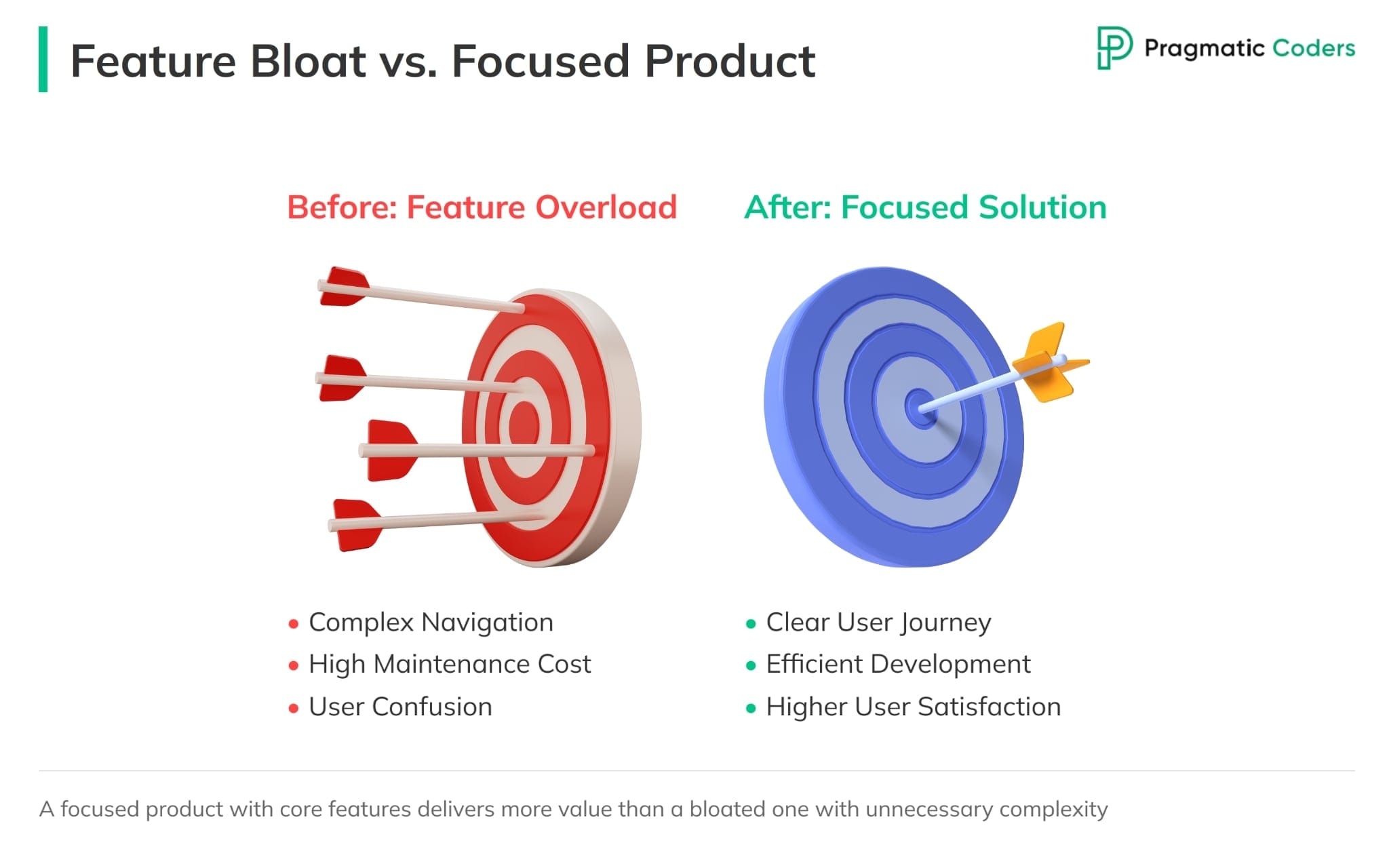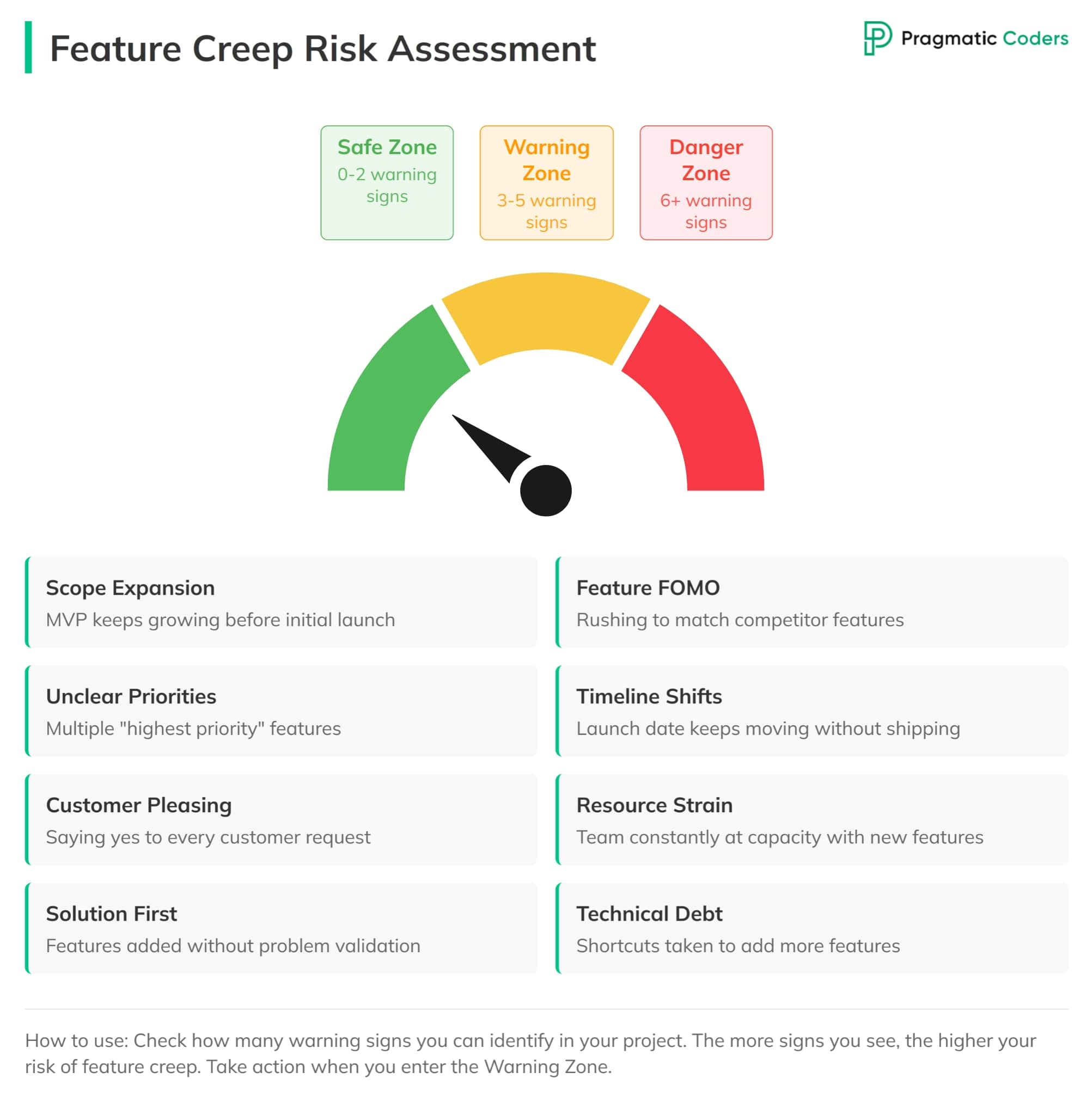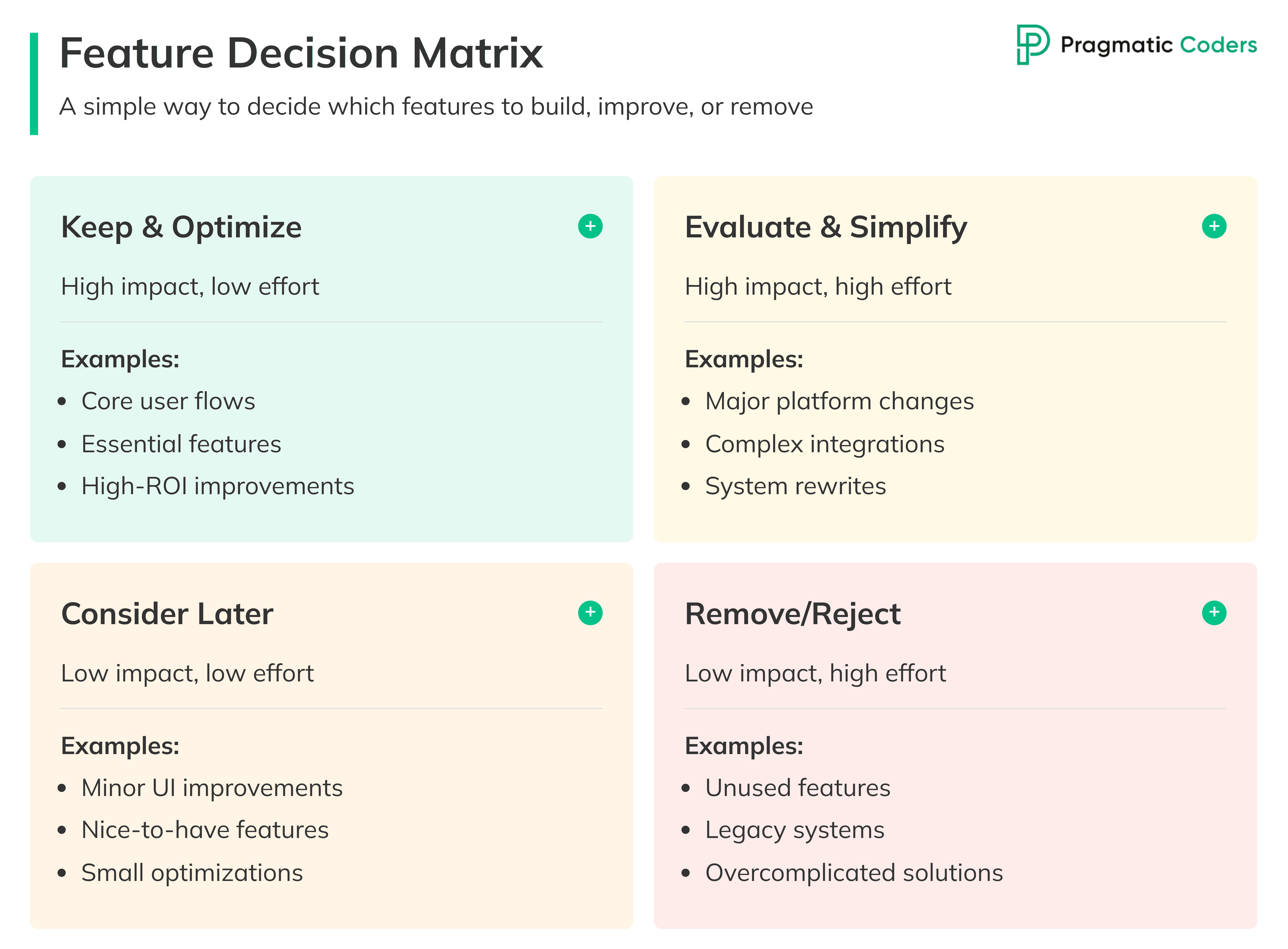Feature creep is costing you thousands: Here’s the fix

Picture this: Your team is building the next big thing. The core product is almost ready, but then someone suggests adding “just one small feature.”
Before you know it, your simple product has turned into a complex beast, your timeline has doubled, and your budget is spiraling.
Sound familiar?
You’re not alone – we’ve seen this story play out countless times, but there’s a pragmatic way to avoid it.
Beat your feature bloat
What is feature creep (from a business perspective)
Feature creep (also know as scope creep or feature bloat) is the gradual expansion of product scope through the continuous addition of new features, each seemingly essential but collectively dangerous.
Let’s look at some real-world examples:
- A messaging app that started as a simple text platform but kept adding voice calls, video calls, stories, and payments until it became too complex for users to navigate.
- An e-commerce startup that delayed launch by six months trying to match every Amazon feature.
The results are substantial:
| Extended development timelines Inflated budgets Delayed market entry Increased technical debt | Confused users Team burnout Missed market opportunities |
What causes feature creep & why good products go astray

In our years of building products for startups and scaleups, we’ve seen feature creep emerge from seemingly rational decisions.
Let’s take a pragmatic look at why even the most focused teams can find their products slowly expanding beyond their original vision.
External pressures
The market can be a demanding taskmaster. When your competitor launches a shiny new feature, it’s natural to feel the pressure to match it. We often hear “They have it, so we need it too” in project meetings. This reactive development approach might feel safe, but it’s actually one of the riskiest paths you can take.
Customer requests present another compelling but dangerous source of feature creep. It’s tempting to say yes when customers ask for new features – after all, isn’t the customer always right? But here’s the catch: what customers ask for isn’t always what they need, and what one customer needs isn’t necessarily right for your entire user base.
Internal dynamics
Inside your organization, feature creep often starts with the best intentions. You can call it the “executive decision-maker syndrome” – when leadership gets excited about possibilities and starts adding “just one more thing” to the scope. These requests often come with urgency and authority, making them particularly challenging to manage.
Your product team itself can inadvertently contribute to feature bloat. Engineers get excited about technical possibilities, the product team wants to innovate, and sales makes promises to close deals. Without a strong “no person” in the process, these natural tendencies can quickly derail your focused vision.
Strategic misalignment
At its heart, feature creep often stems from unclear product vision.
When teams lose sight of their target persona or core value proposition, every new feature request seems reasonable. It’s like trying to navigate without a compass – any direction might seem right in the moment.
Market understanding gaps compound this problem. Insufficient user research or attempting to serve too many market segments can lead to a product that tries to be everything to everyone. In our experience, that’s a reliable recipe for building something that’s perfect for no one.
Psychology factors
The “while we’re at it” syndrome is particularly sneaky.
Each individual addition seems small and reasonable. “It’s just one small feature,” we tell ourselves. “It’ll only take a day to build.”
But these small additions accumulate, and before you know it, your sleek product has become a bloated beast.
The sunk cost fallacy makes it even harder to correct course. Once features are built, teams become reluctant to remove them, even if usage data shows they’re not providing value. This attachment to existing features can trap you in a cycle of increasing complexity.
How to AVOID feature creep

Let’s say feature creep is not your problem-but it doesn’t mean you won’t have to face it some time in the future.
Here’s a set of prevention techniques that will help you avoid feature creep in the first place.
Practical prevention strategies
- Start with clear success criteria:
- Define what “done” looks like before starting
- Set specific, measurable goals
- Document your non-goals
- Implement strong validation processes:
- Require business case for new features
- Use data to drive decisions
- Test assumptions with users first
- Create feature request workflows:
- Standardize the proposal process
- Include impact assessment
- Document opportunity costs
Here’s how we put these prevention techniques into practice: Some time ago, our Product Owner Michał worked with a fintech startup that wanted to build an app analyzing worldwide real-time transactions. Initial estimates from other providers ranged from $2M to $15M.
Instead of jumping into features, we asked “why?”
The client needed something to show investors – they didn’t need a full-scale solution yet. Using user story mapping, Michał helped reduce the scope by 90%, focusing only on core features that would prove the concept’s value.
The result?
A successful prototype delivered for $80K in just three months that helped secure funding.
This wasn’t about cutting corners – it was about making pragmatic decisions based on real business goals. By preventing feature creep before it started, we saved both time and money while still delivering exactly what the client needed for their next business milestone.
Remember: Sometimes the best way to prevent feature creep is getting better at understanding what you really need to say “no” to.
When to say no (and how)
Saying no is a skill. Here’s how to do it professionally:
- Acknowledge the suggestion’s merit
- Explain your reasoning with data
- Offer alternatives
- Keep focus on shared goals
For example: “That’s an interesting feature idea. Based on our user research, only 2% of users would benefit from it, but it would take 30% of our remaining development time. Could we instead focus on Feature X that would benefit 80% of users?”
How to HANDLE existing project creep
Let’s be honest – sometimes we realize we’re deep in feature bloat territory only when we’re already there.
Maybe you’ve inherited a complex product, or your simple app has gradually evolved into something that makes Swiss Army knives look straightforward.
Don’t worry – we’ve helped many companies navigate out of this situation.
Assessment: Getting real about your situation
First, we need a clear picture of where we stand. This isn’t about pointing fingers – it’s about understanding your current state to make informed decisions.
Start with a feature inventory.
Map out everything your product does and gather three critical data points for each feature:
- How often is it actually used? (Not how often you think it’s used)
- What does it cost to maintain?
- What concrete business value does it deliver?
Prioritization: Making tough decisions

Once you have your data, it’s time for some pragmatic prioritization. Look at each feature through these lenses:
Impact vs. Effort: Plot your features on a simple matrix:
- High impact, low effort: Keep and optimize
- High impact, high effort: Evaluate for simplification
- Low impact, low effort: Consider removing
- Low impact, high effort: Prime candidates for removal
Cost vs. Value: Calculate the real cost per user for each feature. Some companies spend thousands monthly maintaining features used by just a handful of users. Would those resources be better spent elsewhere?
Strategic Fit: Does this feature still align with where your product is heading? Sometimes features that made sense a year ago don’t fit your current direction.
Taking action: The smart way to slim down
Here’s the challenging part – actually removing or simplifying features. But there’s a pragmatic way to do this:
Start with the obvious wins
- Remove clearly unused features
- Simplify overcomplicated workflows
- Consolidate duplicate functionality
First, look for the low-hanging fruit – features that are clearly candidates for removal or simplification. These are typically the easiest to address and can demonstrate quick wins to stakeholders.
Unused features are your first target. By analyzing usage data over a 3-month period, you can easily identify features that see less than 1% engagement.
Next, tackle overcomplicated workflows. These are often easy to spot as they generate the most support tickets or have high drop-off rates.
Don’t forget about duplicate functionality. It’s common for products to accumulate multiple ways to accomplish the same task, like multiple import/export features. Consolidating these into a single, robust solution not only simplifies the user experience but also reduces maintenance overhead.
Plan your changes
- Identify dependencies between features
- Create a phased removal approach
- Prepare migration paths for affected users
Before removing any features, you need to understand their place in your product ecosystem.
Create a dependency map, but keep it practical.
When it comes to implementation, a phased approach is your friend. Rather than removing features overnight, consider a gradual rollout. Start by hiding features from new users, then show deprecation notices to existing users. This gives you time to gather feedback and adjust your approach if needed.
Migration paths are crucial. Users who relied on the removed features need clear alternatives.
Communicate effectively
- Explain the benefits of simplification
- Provide alternatives where needed
- Give users time to adjust
The success of your feature removal often depends more on communication than technical execution. Focus on the benefits – faster system, cleaner interface, better performance. Back these claims with data when possible.
Instead of just listing alternatives, show users how to achieve their goals with the remaining features. Create guides that focus on outcomes rather than features.
Timing is everything. Give users enough notice to adjust their workflows, but not so much that they ignore your communications. A 90-day timeline works well for major features, with reminders at key intervals. For enterprise customers, consider offering extended support or custom migration assistance.
Monitor and adjust
- Track user feedback
- Watch for unexpected impacts
- Be ready to adjust your plan.
The true test of successful feature removal isn’t just in the code you delete – it’s in the metrics that follow. Watch for decreasing support tickets, improved performance metrics, and stable (or improving) user satisfaction scores.
The pragmatic takeaway
Feature creep cleanup isn’t a one-time project – it’s an ongoing process. Yet, it’s worth the effort. Every feature you remove is:
- One less thing to maintain
- One less thing to test
- One less thing to document
- One less thing to confuse users
Your goal is to have the right features that deliver real value to your users. Sometimes less really is more, especially when it comes to building products that users love and teams can maintain efficiently.
Want to keep your project on track? Start by asking, “What can we remove?” instead of “What can we add?”
That’s the pragmatic way to build successful products.
Need help deciding what stays and what goes? Remember, an experienced partner can offer the outside perspective needed to make these tough decisions objectively.
15 ways to beat feature creep






